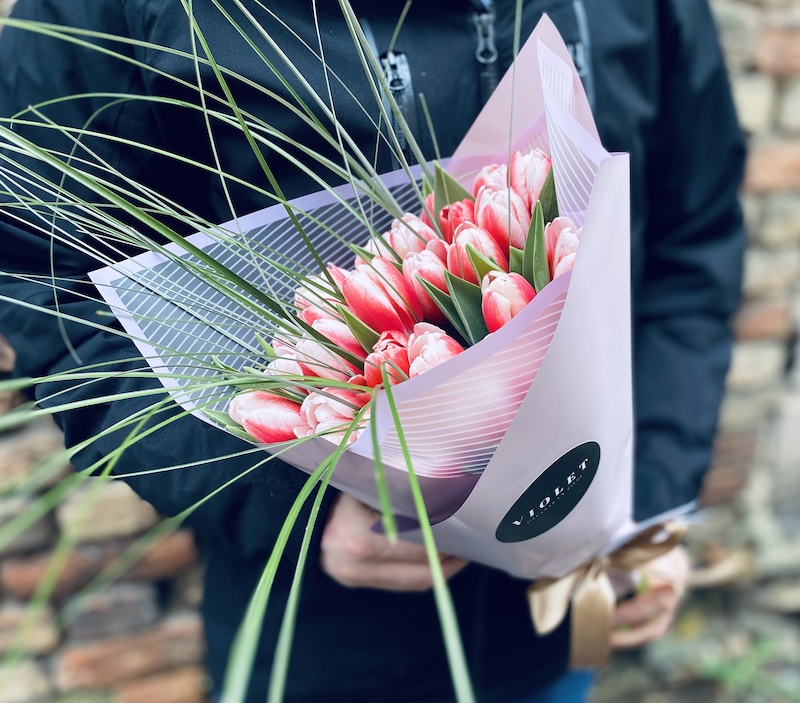+371 20523707
No products
Product successfully added to your shopping cart
There are 0 items in your cart. There is 1 item in your cart.
Tulips - cultivation, breeds and classification
Published : 02/18/2020 17:17:43
Tulips are one of the world's most beloved and recognized flowers. They are the first messages of spring and a symbol of love, tenderness and femininity.
Tulips have their origins in Persia and Turkey, where they played an important role in the art and culture of that time. The Turks had a tradition of wearing tulips in their turban, so the Europeans mistakenly gave the tulips its name, derived from the Persian word for turban.
When Europeans started to use tulips, the popularity of flowers quickly spread, especially in the Netherlands, where at one point in the 17th century a phenomenon called tulip mania occurred. Tulips are now grown worldwide, but people of the cultivated variety still identify as 'Dutch tulips'.
Like many flowers, tulips of different colors often play a role. Red tulips are most closely associated with true love, while purple symbolizes respect. The meaning of the yellow tulips has evolved slightly, from the once hopeless love to the common expression of amusing thoughts and sunlight. White tulips are used as a prayer for apology and forgiveness.

CLASSIFICATION OF TULIPS
Tulips are divided into 15 classes, which are divided into 4 groups. Tulips are divided into groups by flowering period: early flowering tulips belong to the first group, medium flowering tulips belong to the second group, and late flowering tulips belong to the third group. Group 4 includes tulips by their origin, this group includes all wild species.
First group: early flowering tulips:
Group 1 Simple late tulips,
Group 2 Stuffed early tulips
Second group - medium flowering tulips:
Group 3 Triumph tulips,
Group 4 Darwin Hybrid Tulips,
Third group - late flowering tulips:
Group 5 Simple late tulips,
Group 6 Lilies of the valley,
Group 7 Rose tulips
Group 8 Green-flower tulips
Group 9 Rembrandt tulips
Group 10 Parrot tulips
Group 11 Filled late tulips,
Fourth group - species and their hybrids:
Group 12 Kaufmann tulips
Group 13 Foster tulips
Group 14 Greigii tulips
Group 15 Wild tulips and hybrids
BREEDS AND CLASSES
Grade 1. Simple late tulips.
Simple late tulips are characterized by low and strong stems (40 cm). The late tulips are rain and wind resistant. The flowers and leaves are cup-shaped. These tulips are characterized by red and yellow colors. First-class tulips are characterized by early flowering. On sunny and clear days, the flowers of these tulips open quite wide. Class 1 varieties are used for growing in pots, planting on the edges of greenery. Not suitable for cutting due to their low stems. Class 1 tulips are relatively small and account for only 5.1% of all tulip classes.
Grade 2. Stuffed early tulips.
Second-class tulips have a small stem - 30 cm, their flowers are filled, usually warm, full-blossom flowers up to 8 cm in diameter.
The stems are strong, but after the rain the flowers can fall off the ground. Class 2 tulips are used for planting in flower beds. Second class accounts for 5.5% of tulip classes.
Grade 3. Triumph tulips.
These tulips have large calyx flowers, high stems and good reproductive rate. The flower color of the 3rd class tulips is the most diverse: from snowy white to purple. Triumph tulips bloom in April for a long time and retain their shape perfectly. Triumph tulips are quite widely used in greenery and are intended for cutting. Today it is the largest class of tulips - 25%.
Grade 4. Darwin Hybrids.
Class 4 are large tulips: they are 80 cm high and have a flower diameter of more than 10 cm. Darwin tulip hybrids have large calyx flowers, red, but nowadays there are varieties with two-tone coloring. Darwin hybrids bloom in May. Darwinian hybrids have a high degree of selection. The only disadvantage of these tulips is the intense flower opening, especially in hot weather. There are also benefits - their flowers tolerate frost and cut them for a long time. This class occupies 4.5%.
Grade 5. Simple late tulips.
Fifth grade tulips are tall (75 cm) with large scapula flowers and not sharp broad petals. The late tulips come in a variety of colors: white, black, light pink, purple, some varieties even have two-tone colors. Grade 5 also includes multi-flowered tulips, which can have 5 flowers per stem. These tulips bloom in May. Used in landscaping, suitable for cutting. Fifth grade includes 20.3%.
Grade 6. Lilies of the valley.
These tulips are easily recognizable because they resemble a lily flower in their shape. Lilies of the valley are long (up to 60 cm), with strong stems and flowers of various colors. The flowering of lily of the valley flowers begins in May and is popular for landscaping. The lily of the valley class is only 3% large.
Grade 7. Fringed tulips.
The most characteristic feature of these tulips is the fringe along the edges of the petals that resemble a fine needle. The height of these tulips is up to 80 cm. The colors of the flowers are very diverse, from white to purple with the exception of black tulips. Nowadays, class 7 is comprised of 2.5% of the tulip range and is constantly being supplemented by new varieties.
Grade 8. Green flower tulips.
Green flower tulips have a pronounced color contrast, colored in different colors - white, red, pink, yellow - and these tulips look unusual. Nowadays, green flower tulips are very topical. Eighth grade tulip heights may vary. The flowers are 5 cm long, the leaves are narrow, not large. These tulips bloom in mid-May. The green tulip class is 1.6%.
Grade 9. Rembrandt tulips.
This class includes colored tulips. Rembrandt tulips have large, cup-shaped flowers with spots and strokes on a white or red background. Stem height 70 cm. Rembrandt tulips bloom in May. Currently, this is the smallest class of tulips.
Grade 10. Parrot tulips.
The petals of these tulips are cut along the edges, sometimes wavy, and resemble parrot feathers. The flower may have a diameter of 20 cm. The colors of the parrot tulips are different: from snow white to black. The stem is approximately 65 cm high.
Blooms late, late May. Sometimes weak stalks cannot hold large flowers and break.
Grade 11. Filled late tulips.
The thick double flowers of these tulips resemble peony flowers, so they are sometimes called peony tulips. Filled late tulips have strong stems, 60 cm long.
They are distinguished from filled early tulips by the large flowers and the late flowering. These tulips have one disadvantage: heavy flowers often break in the rain and strong wind.
The colors of late-filled tulips range from snow white to black, and sometimes are two-tone. The number of late tulips is approximately 3.2%.
Grade 12. Kaufmann tulips.
These tulips are characterized by early flowering and small stem (up to 25 cm). The flowers are elongated and large - star-shaped. The color can be: yellow, pink, red, sometimes two-tone. The leaves of some Kaufmann tulips have purple spots and streaks. Kaufman tulips make up 2.9% of the tulip class.
Grade 13. Foster tulips.
These tulips have large flowers. Cup-shaped flowers, oblong, reaches 15 cm in length. Mostly in red, sometimes yellow or pink. Height 45 cm, and these tulips bloom in April. There are varieties with decorative foliage with purple stripes and spots. Foster tulips make up 3.5%.
Grade 14. Greigii tulips.
These tulips are small (25 cm) but have large flowers with a rather broad base and slightly curved petal tips. The flower color is red or two-tone. Greigii tulips have decorative variegated leaves. Blooms in April.
Grade 15. Wild tulip species.
This class includes all wild species. Usually blooms early, flower colors may be different. Tulips are quite grateful plants and will accept any soil and location, but it is better to keep them in good condition during flowering. Therefore, care should be taken when growing them: soil preparation and site selection, proper tulip planting, cultivation, bulb care and storage.
Improper preparation, planting or storage is a major cause of tulip diseases and pests.

CULTIVATION OF TULIPS
The beautiful shape, the variety of colors and the ease of cultivation make tulips very quickly conquer the hearts of consumers.
Landscapes, parks and backyard gardeners are especially popular for tulips because of their variety, ease of care and the length of flowering of different varieties. Tulips are a versatile flower, and the vast variety of tulip varieties will satisfy any gardener.
The diversity of tulip varieties allows you to choose varieties that enjoy flowering from early April to June.
Only a few ornamental flowers can compete with tulips in a variety of flower shapes. Tulips with cup-shaped flowers look beautiful among lawns or in parks under trees. When planting tulips under tree crowns, care should be taken to avoid tulips in the shade.
Tulips should be exposed to sunlight for at least half a day. In addition, the place should be protected from the wind, not because it will reduce the flowering period of ornamental tulips, but they will quickly lose all petals.
Wild tulips, with their low altitude and disease resistance, are excellent for planting in the Alpine mountains.
You can use tulips for planting in flower pots or flower boxes for balconies. To do this, fill the dishes with soil and plant healthy, large tulip bulbs. In winter pots with onions should be stored in a cold and dark room. The soil in the tank must be moistened to prevent it from drying out. Flower pots with tulip bulbs can also be stored on the balcony, but then the bulbs must be carefully covered.
Get the most beautiful flowers, bouquets and flower boxes for Women's Day on March 8th at our VIOLET.LV online flower shop. We will provide fast and high quality flower delivery in Riga, Jurmala and the nearest cities of Latvia.
Share this content
Feedbacks



 What to write on a greeting card and add to a bouquet of flowers?
What to write on a greeting card and add to a bouquet of flowers?  FLOWER DELIVERY IN JURMALA
FLOWER DELIVERY IN JURMALA  Tulips - cultivation, breeds and classification
Tulips - cultivation, breeds and classification
I recommend great service :-)
Labākās cenas un apkalpošana! Mans jubilārs saņēma superī...
Все супер! Очень красиво всё сделали и доставили вовремя!...
Абсолютно замечательный сервис! Очень свежие цветы с минд...
Отличный сервис, все пожелания учтены, доставлено в срок....
Сегодня в Эстонии отмечается День от отца, но мой папе уе...
Nekas pieliekams, ne atņemams; Jūs visu darat pareizi, no...
Thank You so much for roses and eclair delivery to my dau...
Очень нежный, красивый букет.. ????
Отличный сервис! Заказывал жене цветы на день рождения. ...
Дякую Вам! Дружині дуже сподобалися квіти. Ви робите кори...
Superīga dāvana mīļam cilvēkam! Pats process ļoti vienkār...
Всё было сделанно на уровне. Доставленно вовремя. Каждое ...
The team at Violet did a fantastic job. I placed this ord...
The team at Violet did a fantastic job. I placed this ord...
Diemžēl pēdējo reizi ziedu pušķis neizskatījās ar svaigie...
Восхитительный букет, супер профессиональный сервис и спа...
СЕРВИС НА ВЫСШЕМ УРОВНЕ. КРАСИВО, КАЧЕСТВЕННО, СДЕЛАНО С ...
Lieliska komunikācija pa telefonu. Piegāde perfekti laikā...
Букет просто шикарный, спасибо. И огромное спасибо за ши...